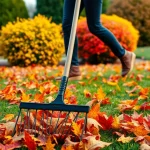
Understanding Fall Clean Up
What is a Fall Clean Up?
Fall clean up is a comprehensive maintenance routine for your lawn and landscaping as autumn sets in. This process involves gathering and disposing of fallen leaves, trimming perennials, cleaning flower beds, and preparing your outdoor space for the winter ahead. It’s not just about aesthetics; it’s essential to maintain the health and vitality of your lawn throughout the colder months. This service aims to ensure that your yard remains healthy and vibrant, nurturing both the soil and the plants during the transition into winter.
Importance of Seasonal Lawn Maintenance
Regular seasonal maintenance, particularly in the fall, is crucial for several reasons. First, it protects your lawn against winter damage by promoting good air circulation and preventing excess moisture retention, which can lead to mold growth. Additionally, efficient leaf removal reduces the risk of lawn diseases, ensuring your grass enters dormancy in good condition. As the grass slows its growth in cooler temperatures, fall cleanup is an opportune time for fertilization to strengthen roots, making them more resilient against freezing temperatures.
Types of Services Involved in Fall Clean Up
Fall cleanup services comprise various tasks tailored to meet your lawn’s specific needs. Some of the most common services include:
- Leaf Removal: Efficiently removing leaves with blowers, rakes, or vacuum equipment to prevent mildew and promote a healthy lawn.
- Trimming and Pruning: Cutting back overgrown plants, flowers, and shrubs to prepare them for winter and encourage healthy growth in spring.
- Debris Cleanup: Clearing away any debris, like fallen branches and twigs, from your lawn and landscape beds to enhance the overall look and health of your garden.
- Weeding: Removing weeds from garden beds to minimize competition for nutrients and resources that your plants will need as they prepare for dormancy.
- Soil Aeration: Aerating the soil improves water retention and nutrient absorption, vital for lawn health.
Key Benefits of Fall Clean Up
Enhancing Lawn Health and Resilience
One of the most significant advantages of a fall clean up is the enhancement of your lawn’s health and resilience. This seasonal upkeep enables grass roots to absorb nutrients better, especially when accompanied by fertilization. Fall is also when grass can store energy for a vigorous growth spurt come spring. Regularly maintaining your lawn now will create a strong foundation that can withstand the stressors of winter, including severe weather and pests.
Preventing Pests and Mold Growth
Overwintering pests, such as grubs and beetles, can wreak havoc on lawns in the spring. By conducting thorough fall clean up, you significantly reduce potential pest habitats. Moreover, decaying leaves and organic matter can promote mold and fungal growth, which harms your lawn. By ensuring a clean and airy environment, you lower the risk of these issues, promoting a healthier ecosystem for your plants.
Improving Curb Appeal
Aside from health benefits, fall clean up greatly enhances your home’s curb appeal. A well-maintained lawn and yard can improve the overall aesthetic, potentially increasing your property’s value. A tidy yard free of leaf litter and debris reflects care and attention, which can be especially beneficial if you’re considering putting your home on the market in the near future.
DIY vs. Professional Fall Clean Up Services
When to Do It Yourself
Doing the fall clean up yourself is a viable option if your yard is relatively small and manageable. If you enjoy gardening and have the appropriate tools, this can be a fulfilling task that allows you to engage with nature actively. Essential tools such as rakes, blowers, pruners, and bags for debris collection are typically all that’s needed. This DIY approach can save money and provide a sense of personal satisfaction.
When to Hire Professionals
Hiring a professional service may be more beneficial for larger properties or if you’re dealing with specific challenges, such as a particularly overwhelming number of leaves or intricate landscaping that requires expertise. Professionals come equipped with specialized tools, expertise in tackling different landscaping issues, and a strategic approach to ensure that your lawn receives the care it deserves. Additionally, they can help with more labor-intensive tasks, such as soil aeration and heavy lifting.
Cost Considerations for Both Options
Cost is a considerable factor when deciding between DIY and professional services. On average, hiring a professional lawn service for fall clean up can range from $200 to $500, depending on the size of your property, the extent of required services, and geographic location. In contrast, completing the tasks yourself can incur only the cost of tools and equipment, which may total significantly less if you already have the necessary items. However, be realistic about your ability to perform the work required and consider the value of your time.
Creating Your Fall Clean Up Checklist
Essential Tasks to Include
To ensure an effective fall clean up, it’s crucial to create a checklist of essential tasks. Your checklist might include:
- Remove all leaves from the lawn and garden beds.
- Trim back any perennials and shrubs.
- Clean up garden decor and furniture for storage.
- Weed flower beds and vegetable patches.
- Test the soil and amend accordingly with nutrients.
- Apply a final fertilizer treatment to promote healthy root development.
- Aerate the soil if necessary.
Tips for Efficient Execution
To make your fall clean up as efficient as possible, consider the following tips:
- Work on a dry day to avoid muddy conditions.
- Utilize proper tools to speed up your process, such as leaf blowers and bagging mowers.
- Set realistic goals for each cleaning day based on your capacity and time available.
- Involve family members or hire help if the tasks are extensive.
- Consider composting leaves and organic material to reduce waste.
Post-Clean Up Maintenance Strategies
After the heavy lifting of fall clean up, consider implementing regular maintenance strategies to keep your yard in top shape through winter. Regular inspections for pests, especially around mulch areas, are crucial. Keep plant beds mulched to protect roots from frost and water regularly if there’s insufficient rain. Additionally, a final application of fertilizers before the ground freezes can set your lawn up for success in the spring.
Schedule and Timing for Fall Clean Up
Best Time to Start Your Clean Up
The best time to start your fall clean up is typically in early to mid-autumn, ideally between late September and late October. This schedule aligns with the typical leaf drop period, allowing you to clean without excessive delays or the buildup of leaves. It’s generally recommended to work on fall clean up before heavy frost or snow begins, which can make maintenance more difficult.
Weather Considerations
Always keep an eye on the weather when planning your clean up schedule. Ideal conditions typically involve dry, mild days that make it easier to gather leaves and perform any required aeration. If the forecast predicts rain, snow, or extreme temperatures, it may be necessary to adjust your plans accordingly.
Planning Around Fall Activities
During the fall season, numerous activities can conflict with your clean-up plans, such as sports events, festivals, and holidays. Try to set aside specific weekends or days that align with your availability. Additionally, consider planning your clean up around these events to make the most of your time while ensuring your yard stays healthy. Engaging with family members during weekends can also turn the activity into a fun and fulfilling family project.







